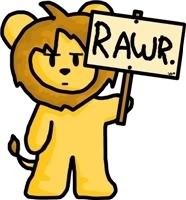Post by lion on Dec 19, 2015 19:27:36 GMT -5

Official Weapon Name:
Trandoshani Sword/Scorekeeper's Fang.
Faction/Affiliation:
Trandoshan Hunters
Classification:
Sword
Stock/Custom
Custom, each sword differs from user to user.
Manufacturer:
Trandoshan Blacksmiths primarily; not mass-produced.
Dimensions:
Length:
100cm from blade point to crossguard.
Weapon weight:
6.5 Kilograms
Composition:
Purified Chalon, silk-wrapped handle, gold inlay on the handle.
Other: Thanks to the surprisingly dense and strong layout of atoms composing Chalon, the blade is partially lightsaber resistant; able to deflect and brush away much of a lightsaber's contact by repelling it. This is by no means foolproof, however, nor does it mean Chalon can indefinitely stand up to the Jedi weaponry; the metal can only handle so many glancing blows before it weakens, and one or two direct hit from a sufficiently powerful blow will out and out shear clean through. Even the lightest of contacts requires hours of maintenance afterwards, and often prior as well, with hunters cleaning and resharpening blades if contact with a Jedi is expected. The fabled blade, Red Fang, is perhaps the most famous example of the sword's failure against lightsabers; being cut with one stroke from a Jedi's lightsaber.
Description: Among the Trandoshan culture, swords carry social status and remain symbols of high power, distinction, and skill; not merely weapons to be discarded but prized objects to be treasured, and a strong part of the reptilians' culture. Many tales of folklore surround these weapons, both real and rumoured, with some of the named blades being seen as almost sentient by some. It's not uncommon to see familial blades adorning a Trandoshan's home, with some potentially reaching as far back as pre-space age, and even further, passed down from hunter to hunter and generation to generation, building the legacy.
The weapon is, by human standards, very heavy for a single-handed sword, but for Trandoshans this sword is for single hand use only. The ergonomically curved grip is tailor suited to the hunter's palm, before being bound in padding and black silk; providing not only supreme control but comfort. Manipulated by broad strokes of the arm for chopping and cutting, or even light turns of the wrist, thrusts and slashes are the staple of the weapon, though cuts tend to be the preferred method of attack.
Whilst custom to each hunter, some uniform traits such as the curved handle and crossguard remain, with many modern blacksmiths providing a rather unique micro-serration pattern to the blade, rather than a flat edge. Sadistically painful, with the teeth generally angled toward the crossguard rather than outward, these micro-serrations are akin to being hit with a saw; the blade bites into its target as it hits, and tears rather than simply slicing as it is pulled through, adding another level of trauma to an already punishing weapon. If it doesn't kill outright, bleed-outs are exceptionally common, as the tearing of blood vessels only further accelerates the blood loss; many famed Trandoshan folklore duels result in the deaths of both hunters, thanks in part to this savage addition.
Among the hunting upper classes of Trandoshan society, these are the honour weapons; great pride is taken in their use and care. Made specially for each hunter after their first successful kill (and generally, many years in childhood practising with wooden mimics), the sword is then blessed by either the highest-ranked hunter available in a ceremony, devoting the blade to the Scorekeeper's will in an effort to implore favour, and then named.
This is considered an extremely important part of a hunter's life; it's considered as important as baptism in many cultures, if not more, as it is viewed to ensure success in a hunter's future. Likewise, failure to correctly adhere to the traditions surrounding this process carries great superstition among Trandoshans; unblessed blades are repeatedly mentioned in folklore as cursed weapons, destined to rot the mind and bring ruination to any who bear the misfortune or arrogance to wield them.
Among the most prized weapons of any hunter's collection, often reserved for intra-species duels rather than actual pursuits, it is considered a mark of pride for someone to be killed by one; likewise, killing a hunter with their own sword is a gesture of immense disrespect, enough to, in some cases, warrant vendetta among the deceased's survivors.
Watching a fencing bout between Trandoshans using these blades can be as gruesome as butchery, death on both sides has been known to occur, and even the most graceful display appears nothing short of utter violence. It's a great, messy cleaver one moment, but as delicate as a fencer's sabre the next, but much like their wielders in the Trandoshans, they are nothing short of purpose-bred killing machines. Scarier still, the single-hand fencing aspect branches not as a separate martial art, but as an extension of their indigenous hand to hand form; unarmed attacks are frequently chained into swordplay, with punches, kicks, head-butting and grappling featuring alongside swordplay in a fluidly-transferable multi-form.

